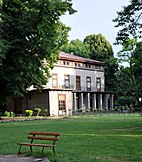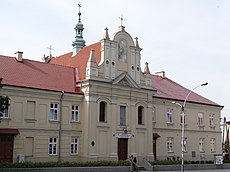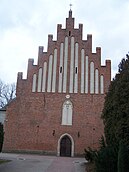Przeworsk
Przeworsk | ||
|---|---|---|
Market Town | ||
 Town Hall | ||
|
Car plates RPZ | | |
| Website | www | |
Przeworsk (Polish:
Przeworsk was a settlement since the 10th century, though evidence of human settlement in the general area is even older. It is first mentioned in historical records from the 13th century, and was granted its town charter in 1394. From 1772 the town was part of the Habsburg monarchy where it remained until 1918 when an independent Poland returned. Przeworsk is located on European route E40. It also is an important railway junction, with trains going in three directions – east (towards Przemyśl), west (towards Rzeszów) and north (towards Stalowa Wola).
Przeworsk has some 60 historic buildings, including two fortified Gothic abbeys, a town hall, the Lubomirski Palace in classical style, a baroque monastery, and an open-air museum (skansen). The town covers an area of 22 square kilometres (8.5 square miles).
History
Name variations
In 13th century Ruthenian documents, Przeworsk was spelt Pereworesk. In the 14th and 15th centuries, its name was subject to variation. It was called Preworsko, Przeworsko, Przeworszko, Przeworscho, Przeiworsko, Przyworsko and Prziborsko. Since the 15th century, the name Przeworsko was most often used.
Recorded history
In the early
"Въ лѣт̑ 6789 (1281) Иде Льстько на Лва и взѧ оу него городъ Переворескъ и исъсѣче и люди в нем̑ вси ѿ мала и до велика и город̑ зажьже и поиде назадъ во своӕси"[2]
In the year 6789, (1281) Leszek attacked Leo I of Galicia, and took his city of Perevoresk and killed all in it, sparing neither young or old and having burnt the town to the ground he left.
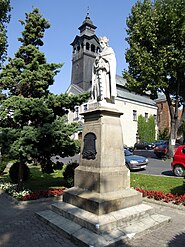
After the
Until the 18th century, Przeworsk was a
Since
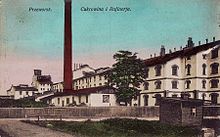
In First Partition of Poland, in 1772, Przeworsk was annexed by the Habsburg Empire, remaining in Austrian Galicia until November 1918. In the late 18th century, the Austrian authorities pulled down the obsolete late-medieval ramparts and gates. The town remained in decline until the late 19th century, when it became a railway junction, and a center of sugar production, with the Przeworsk Sugar Refinery (1895). In 1859, Przeworsk was connected by rail with Kraków by the Galician Railway of Archduke Charles Louis. In 1902 it had a new railroad to Rozwadów, and in 1904, a narrow gauge line to Dynów was completed. The population began to grow, new housing was built, together with a monument dedicated to King Władysław II Jagiełło (1910), but World War I brought destruction to the town.
In 1918 Poland regained independence, and in the Second Polish Republic Przeworsk was part of Lwów Voivodeship. In 1929, it became of a county seat and in 1930, several buildings burned down in a fire.
During the joint German-Soviet
The Pshevorsk Hasidic dynasty, which originated in Przeworsk, is now mainly located in Antwerp, Belgium.
Tourist attractions
- Basilica of the Holy Spirit, built in the 15th century with a unique chapel – Tomb of Jesus Christ (the same as in Jerusalem)
- Gothic Church of the Bernardine Order
- Palace and park of Lubomirski family
- Baroque Daughters of Charity monastery and Our Lady of the Snow church
- Gothic defensive town walls
- Monument of Polish King Władysław II Jagiełło at the Rynek (Market Square)
- The only truly "vivid" open-air museum in Poland, with wooden houses from Przeworsk and the surrounding region.
- The Wąskotorówka Train (narrow gauge railway) going from Przeworsk to Dynów.
- Firefighting Museum
Sport
The local football team is Orzeł Przeworsk. It competes in the lower leagues.
People associated with Przeworsk
- Piotr Aigner– architect of the Lubomirski Palace
- Fryderyk Bauman – architect, sculptor and designer of the Lubomirski Palace interiors
- Andrzej Ćwierz – Member of the Sejm
- Sisters of St. Vincent de Paulconvent and church
- Zofia Lubomirska – founder of the vast textile and silk factories
- Izabela Maria Lubomirska – princess
- Henryk Ludwik Lubomirski – prince
- Paweł Miesiąc – Motorcycle speedway rider
- Zygmunt Mycielski – composer and musicologist
- Tadeusz Rut – athlete
- Andrzej Sztolf – Olympic ski-jumper
- Stanisław Żuk – creator of the Skansen Museum and shepherd
International relations
Twin towns – Sister cities
Przeworsk is
References
- Notes
- ^ "Population. Size and structure by territorial division" (PDF). 1995–2009 Central Statistical Office 00-925 Warsaw, Al. Niepodległości 208. 2 June 2009. Retrieved 22 June 2009.
{{cite web}}: External link in|publisher= - ^ Ruthenian chronicle after the Hypatian list, Galicia-Volhynian chronicle
- ^ "Muzeum w Przeworsku wspomina pierwsze dni II wojny światowej". MojPrzeworsk.pl (in Polish). Retrieved 28 December 2020.
- ^ Wardzyńska, Maria (2009). Był rok 1939. Operacja niemieckiej policji bezpieczeństwa w Polsce. Intelligenzaktion (in Polish). Warszawa: IPN. pp. 58–59.
- ^ Wardzyńska, p. 257
External links
- Official website (in Polish)

